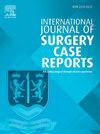Precise diagnosis and effective management of highly vascular anterior mediastinal paragangliomas: A case report
IF 0.6
Q4 SURGERY
引用次数: 0
Abstract
Introduction
Mediastinal paragangliomas are rare neoplasms arising from extra-adrenal neural crest cells, presenting as either functional or nonfunctional tumors. Clinical manifestations range from catecholamine-related symptoms to physical compression effects. Accurate recognition of these tumors is crucial for diagnosis and management due to their rarity and association with vital mediastinal structures.
Presentation of case
We report the case of a 53-year-old Syrian male presenting with progressive dyspnea, fatigue, and weakness. Imaging revealed a highly vascular anterior mediastinal mass compressing the superior vena cava, diagnosed as a nonfunctional paraganglioma. Preoperative evaluations included endocrine consultation and blood transfusion preparations. The tumor was surgically excised via lateral thoracotomy without complications. Postoperative imaging confirmed the absence of residual mass, and two years of regular follow-ups revealed no recurrence or metastasis.
Discussion
Mediastinal paragangliomas pose diagnostic and management challenges due to their rarity and potential for extensive vascular involvement. Nonfunctional paragangliomas, in particular, may remain asymptomatic until they exert significant mass effects. Surgical resection is the definitive treatment, often requiring a multidisciplinary approach. Tumor size and patient age influence malignancy risk and recurrence, highlighting the need for thorough perioperative planning and long-term follow-up.
Conclusion
This case underscores the importance of precise diagnosis, meticulous perioperative management, and surgical intervention in managing mediastinal paragangliomas. Lifelong monitoring is essential, especially for larger tumors, to ensure early detection of recurrence. Comprehensive understanding and documentation of such cases contribute to improved patient outcomes and enhanced clinical management strategies.
高血管性前纵隔副神经节瘤的准确诊断和有效治疗1例。
摘要纵隔副神经节瘤是发生于肾上腺外神经嵴细胞的罕见肿瘤,可表现为功能性或非功能性肿瘤。临床表现从儿茶酚胺相关症状到物理压迫作用不等。由于其罕见且与重要纵隔结构相关,因此准确识别这些肿瘤对诊断和治疗至关重要。病例介绍:我们报告一位53岁的叙利亚男性,表现为进行性呼吸困难、疲劳和虚弱。影像显示前纵隔高血管肿块压迫上腔静脉,诊断为无功能副神经节瘤。术前评估包括内分泌咨询和输血准备。经外侧开胸手术切除肿瘤,无并发症。术后影像学证实无残留肿块,两年定期随访未发现复发或转移。讨论:纵隔副神经节瘤由于其罕见性和潜在的广泛血管累及,给诊断和治疗带来了挑战。尤其是非功能性副神经节瘤,可能在出现明显的肿块效应之前一直没有症状。手术切除是最终的治疗方法,通常需要多学科的方法。肿瘤大小和患者年龄影响恶性肿瘤的风险和复发,强调需要全面的围手术期计划和长期随访。结论:本病例强调了准确诊断、精心围手术期治疗和手术干预在治疗纵隔副神经节瘤中的重要性。终身监测是必要的,特别是对于较大的肿瘤,以确保早期发现复发。全面了解和记录此类病例有助于改善患者预后和加强临床管理策略。
本文章由计算机程序翻译,如有差异,请以英文原文为准。
求助全文
约1分钟内获得全文
求助全文
来源期刊
CiteScore
1.10
自引率
0.00%
发文量
1116
审稿时长
46 days

 求助内容:
求助内容: 应助结果提醒方式:
应助结果提醒方式:


